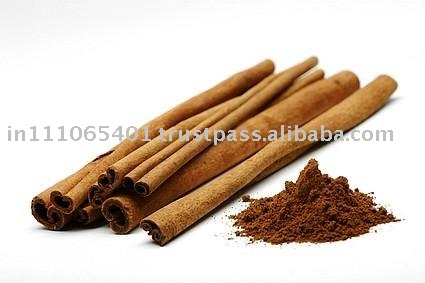
|

Cinnamon is the inner bark of a tropical evergreen tree. There are many different species, between 50 and 250
Cinnamon CO2 extract
Cinnamon
Cinnamomum zeylanicum
Fam: Lauracae
Cinnamon is the inner bark of a tropical evergreen tree. There are many different species, between 50 and 250, depending on which botanist you choose to believe. The two main varieties are Cinnamomum cassia and Cinnamomum zeylanicum. The first, cassia, we will consider separately in its own section. C. zeylanicum is also known as Ceylon cinnamon (the source of the its Latin name, zeylanicum), or ‘true cinnamon’ which is a lighter colour and possessing a sweeter, more delicate Flavour than cassia. A native of Sri Lanka (formerly Ceylon) the best cinnamon grows along the coastal strip near Colombo.
In ancient Egypt cinnamon was used medicinally and as a flavouing for beverages, It was also used in embalming, where body cavities were filled with spiced preservatives. In the ancient world cinnamon was more precious than gold. This is not too surprising though, as in Egypt the abundance of gold made it a fairly common ornamental metal. Nero, emperor of Rome in the first century AD, burned a years supply of cinnamon on his wife’s funeral pyre — an extravagant gesture meant to signify the depth of his loss.
Cinnamon was known in medieval Europe, where it was a staple ingredient, along with ginger, in many recipes. Since most meals were prepared in a single cauldron, casseroles containing both meat and fruit were common and cinnamon helped bridge the flavours. When crusaders brought home sugar, it too was added to the pot. Mince pie is a typical combination of this period which still survives.
The demand for cinnamon was enough to launch a number of explorers’ enterprises. The Portuguese invaded Sri Lanka immediately after reaching India in 1536. The Sinhalese King paid the Portuguese tributes of 110,000 kilograms of cinnamon annually.
The Dutch captured Sri Lanka in 1636 and established a system of cultivation that exists to this day. In its wild state, trees grow high on stout trunks. Under cultivation, the shoots are continually cropped almost to ground level, resulting in a low bush, dense with thin leafy branches. From these, come the finest quills.
Spice Description
Cinnamon comes in ‘quills’, strips of bark rolled one in another. The pale brown to tan bar strips are generally thin, the spongy outer bark having been scraped off. The best varieties are pale and parchment-like in appearance. Cinnamon is very similar to cassia, and in North America little distinction is given, though cassia tends to dominate the market. Cinnamon is also available ground, and can be distinguished from cassia by its lighter colour and much finer powder.
Bouquet: sweet and fragrant
Flavour: warm and aromatic
| Place of Origin: Maharashtra India | Type: Flavoring Agents | Brand Name: ENJAY |